
Technical presentation
| Bottling : | January 2024 |
|---|---|
| Acquired alcohol : | 12.8° |
| Residual sugar : | 2.1 g/l |
| Total acidity : | 4. g/l H2SO4 (6.4 g/l Acide Tartrique) |
| pH : | 3.15 |
| Yield : | 28 hl/ha |
| Optimum tasting : | 2025-2047+ |
| Average age of vines : | Vines planted in 2016 |
| Grape variety : | Riesling |
| Terroir : | Grand Cru Hengst |
| Sweetness index : | 1 |
| Soil : | Calcareous Marl from the Oligocene period, East facing, medium/steep slope |
Description of the wine Riesling Grand Cru Hengst 2022
The Grand Cru Hengst is located on the south-eastern part of the Rotenberg hill in Wintzenheim. The red marl limestone geology always produced (and still does) great Gewurztraminer wines. Despite enjoying a warm and precocious micro-climate, the Hengst takes some time to gain sugar ripeness as the marl soils need more sun energy to warm up. The iron rich mother rock also favours good tannin ripeness, one of the reasons why the Hengst was also recently granted Grand Cru status for red wines. More recently, climate change allowed for more and more plantations of Riesling on this Grand Cru. So when we decided to replace some Gewurztraminer that were planted on the cooler eastern facing part of the Hengst, Riesling was an obvious choice (Pinot Noir would have been too!). Small crop in 2022 (some hail in June), slow and perfect ripeness, allowed for the production of a great dry Riesling.

Tasting notes
01/2024: pale gold colour. The nose is still restraint, almost austere, but revealing floral aromas underlined by the classic limestone tight citrus/mineral influence. It is showing nicely now! Delicate, palate at first, then the powerful Hengst terroir wakes up providing a long-lasting mouthfeel on the finish, ripe acidity, and a harmonious lively balance. Excellent length, attractive bitterness (ripe tannins). Already attractive today but will also last.

The Hengst Grand Cru of Wintzenheim
The Hengst was first mentioned in the 9th century in an endowment of the Murbach Abbey. The lord of Haut Landsbourg as well as the bailiff of Kaysersberg shared the feudal rights up to the Great Revolution, whilst various noble families, abbeys and the bourgeoisie of Colmar exploited important parcels.